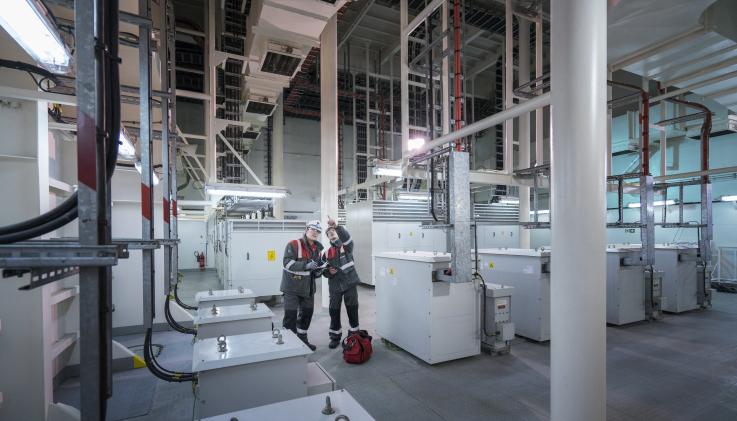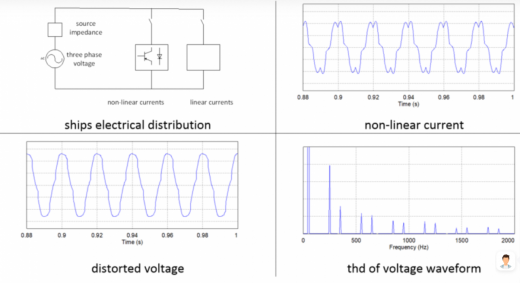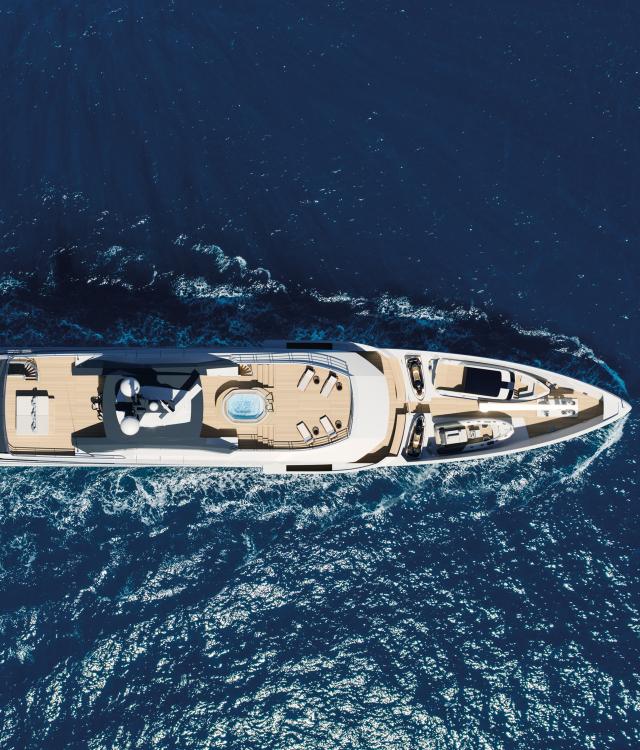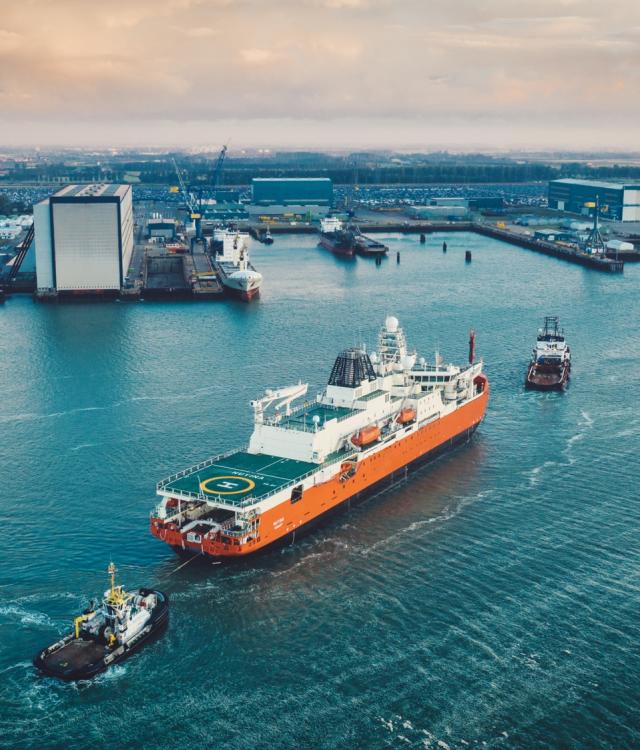Distorsiunea armonică
Analiza, calculul, atenuarea și verificarea distorsiunii armonice sunt esențiale pentru o distribuție de energie extrem de fiabilă la bord, rezultând într-un timp de funcționare maxim și o siguranță operațională optimă.

Calitatea tensiunilor și curenților de la bordul navelor este importantă pentru rețelele lor de curent alternativ (AC). Din acest motiv, societățile de clasificare impun limite privind distorsiunea armonică totală (THD – Total Harmonic Distortion) permisă pentru tensiunea rețelei AC.
De exemplu, conform unei societăți de clasificare precum Lloyd's, THD trebuie să rămână sub 8%, iar componentele armonice individuale de ordin superior celui de-al 25-lea trebuie să fie sub 1,5%. Atunci când distorsiunea se menține sub aceste limite, rețeaua AC și toate componentele sale pot funcționa normal. Dacă distorsiunea depășește aceste limite, tensiunea distorsionată a rețelei AC poate avea un impact negativ asupra duratei de viață și fiabilității sistemelor conectate.
Ce este distorsiunea armonică?
Tensiunile și curenții din rețelele AC au, în mod ideal, o formă sinusoidală, cu o frecvență de bază de 50Hz sau 60Hz. Analiza în frecvență a formei de undă de pe rețea arată că aceasta este compusă din componente armonice, fiecare cu un număr armonic multiplicat cu frecvența fundamentală. Dacă se consideră că o undă sinusoidală pură este ideală, atunci calitatea sau gradul de distorsiune poate fi definit ca raportul dintre partea distorsionată a semnalului și componenta sinusoidală. Acest raport se numește distorsiune armonică.
Această distorsiune este generată de curenți neliniari, atrași în principal de punțile redresoare cu diode (cu sau fără inductanțe de netezire). Componentele armonice ale acestor curenți neliniari duc, la rândul lor, la apariția unor tensiuni armonice în rețeaua AC, cauzate de impedanța sursei de alimentare. Contribuții mai mici la distorsiune provin de la convertoarele cu intrare activă (Active Front End – AFE) și de la generatoarele care alimentează rețeaua.

Activitățile noastre
Pentru a ne asigura că THD-ul rămâne sub 8%, este necesar să se desfășoare mai multe activități în cadrul unui proiect. Noi, în calitate de integrator de sisteme, suntem capabili să desfășurăm aceste activități. Acestea includ:
- Analiză
- Calcul
- Măsuri de atenuare
- Verificare
Analiză
În etapa de proiectare a unei nave noi, este esențială analizarea contribuției încărcărilor liniare și neliniare asupra rețelei electrice pentru fiecare scenariu operațional relevant, ținând cont de configurația planificată a centralei electrice. Este important ca integratorul sistemului electric și șantierul naval să aibă o înțelegere comună asupra contribuției diferitelor sisteme de la bord și asupra diverselor scenarii în care va fi utilizat sistemul de distribuție electrică. Pe baza acestor date, se poate stabili scenariul cel mai defavorabil, în care THD-ul va atinge valoarea maximă.
Calcul
Odată identificate toate încărcările liniare și neliniare, împreună cu impedanța surselor de alimentare și cu caracteristicile încărcărilor neliniare, se pot efectua calcule utilizând un program de simulare electrică. Există mai multe programe disponibile pentru efectuarea acestor calcule.
Atenuare
Dacă în urma calculelor se constată că limitele admise ale distorsiunii armonice sunt depășite, integratorul de sistem va adapta proiectul pentru a respecta standardele necesare. Desigur, aceste măsuri pot avea un impact financiar și pot necesita spațiu suplimentar.
În general, modificările de proiect se aplică consumatorilor, cum ar fi:
- Echiparea unuia sau mai multor convertoare de putere cu un redresor activ (AFE), în locul unei punți cu diode.
- Instalarea unor inductanțe de netezire (smoothing chokes) mai mari pentru punțile cu diode.
- Utilizarea uneia sau a două rețele DC la bord pentru sarcinile mari, alimentate de un convertor de rețea cu AFE.
Dacă modificările de proiect nu sunt fezabile, o abordare alternativă este filtrarea componentelor armonice. Sunt posibile filtre pasive, dar în prezent se pot folosi și filtre active, cunoscute ca Filtre Armonice Active (AHF). AHFs sunt convertoare de putere care generează curenți anti-armonici astfel încât curenții armonici să fie eliminați. Pentru navele aflate în proces de reconversie, AHFs pot fi o opțiune deosebit de atractivă.
Verificare
În final, în timpul testelor de recepție efectuate pe navă, se măsoară distorsiunea armonică. Societatea de clasificare, șantierul naval și integratorul electric trebuie să se asigure că calitatea tensiunii din rețeaua AC respectă normele și standardele agreate. Echipamentele de măsurare a distorsiunii armonice (THD și toate componentele armonice individuale) sunt ușor disponibile și pot fi chiar instalate permanent pentru monitorizare continuă.
Downloads.



